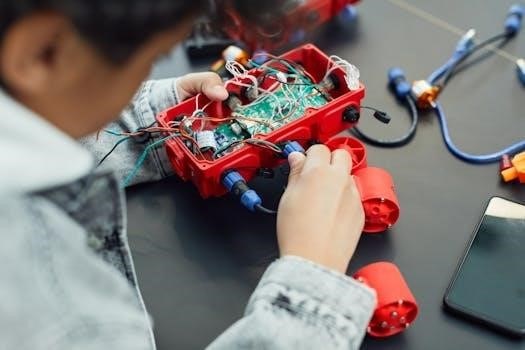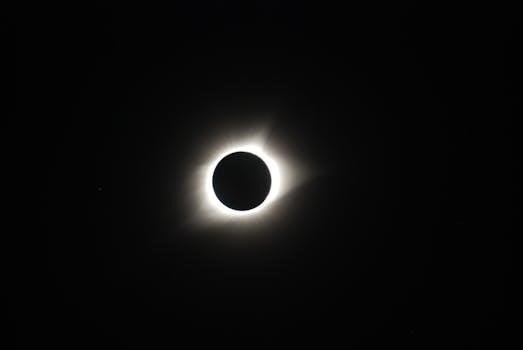Solar Oven Science Project⁚ An Overview
The solar oven science project offers a fascinating way to harness solar energy for cooking. This project combines principles of physics, engineering, and environmental science. Students can learn about heat transfer, reflection, and insulation. Building and experimenting with a solar oven provides hands-on experience and insights into renewable energy sources.
Solar ovens are ingenious devices that utilize sunlight as a renewable energy source to cook food. They present a sustainable alternative to conventional ovens, reducing reliance on electricity or fossil fuels. The basic principle involves trapping solar radiation inside an insulated box and concentrating it onto a cooking area. Reflective surfaces, typically aluminum foil, enhance the amount of sunlight directed into the oven, maximizing heat absorption.
These ovens offer numerous environmental benefits, particularly in regions where access to electricity is limited or where deforestation is a concern. By harnessing solar energy, communities can reduce their carbon footprint and promote sustainable cooking practices. Solar ovens are also relatively simple and inexpensive to construct, making them accessible to a wide range of users.
Beyond their practical applications, solar ovens serve as excellent educational tools. Building and experimenting with these devices can teach valuable lessons about energy conservation, heat transfer, and the potential of renewable energy technologies. They provide a tangible way to understand how solar radiation can be harnessed for practical purposes, fostering a deeper appreciation for sustainable living.

Materials Needed for a Solar Oven Project
Constructing a solar oven is a straightforward process that requires readily available and inexpensive materials. A cardboard box, preferably a pizza box due to its convenient size and shape, forms the primary structure of the oven. Aluminum foil serves as the reflective surface, directing sunlight into the box to maximize heat absorption. Clear plastic wrap, or a transparent plastic bag, creates a greenhouse effect, trapping heat inside the oven and preventing it from escaping.
Insulation is essential for retaining heat within the solar oven. Newspaper, cardboard, or fabric scraps can be used to insulate the sides and bottom of the box, minimizing heat loss. Black construction paper or dark fabric is placed inside the box to absorb solar radiation and further enhance heat retention. Tape, such as duct tape or masking tape, is needed to secure the reflective surfaces, insulation, and plastic wrap.
Additional materials include a utility knife or scissors for cutting cardboard and plastic wrap, a ruler or measuring tape for accurate measurements, and a thermometer to monitor the oven’s internal temperature. A prop, such as a stick or ruler, is used to adjust the angle of the reflective flap, optimizing sunlight capture.
Step-by-Step Instructions⁚ Building a Solar Oven
Building a solar oven involves several key steps, beginning with preparing the box. Next, you will install the reflecting surface. Proper insulation and sealing are crucial. Finally, constructing an adjustable flap to maximize sunlight capture is very important for success.
Cutting and Preparing the Box
First, select a cardboard box, preferably a pizza box or a similarly sized container. Using a ruler and marker, draw a square on the top of the box, leaving a border of about one to two inches on each side. This square will be cut to create a flap.
Carefully use a utility knife or scissors to cut along three sides of the marked square, creating a flap that can be opened and closed. The fourth side should remain attached to act as a hinge. This flap will be used to reflect sunlight into the box.
Next, line the inside of the box with aluminum foil, ensuring that the shiny side faces inward. This foil will reflect sunlight onto the food placed inside the oven. Secure the foil with tape or glue, making sure it is as smooth as possible for optimal reflection.
Finally, prepare a sheet of clear plastic wrap or a clear plastic bag slightly larger than the opening of the box. This will act as a greenhouse effect, trapping heat inside the oven. Secure the plastic wrap tightly over the opening using tape, creating an airtight seal. The box is now ready for the next steps in constructing your solar oven.
Reflecting Surface Installation
The next crucial step is installing the reflecting surface to maximize sunlight capture. Begin by covering the inner side of the flap with aluminum foil, securing it tightly with tape or glue. Ensure the foil is smooth and wrinkle-free to optimize reflection. This flap will act as a primary reflector, directing sunlight into the oven.
Next, consider adding additional reflectors to the sides of the box. Cut pieces of cardboard to fit the inner walls and cover them with aluminum foil, securing them with tape or glue. These side reflectors will further concentrate sunlight onto the cooking area.
Adjust the angle of the flap to direct sunlight effectively into the box. You can use a stick or a piece of cardboard to prop the flap open at the desired angle. Experiment with different angles to find the one that maximizes the amount of sunlight entering the oven.
Ensure that all reflective surfaces are clean and free of debris to maintain optimal reflectivity. Regularly wipe down the foil with a soft cloth to remove any dust or smudges. A well-installed reflecting surface is essential for efficient solar oven performance.
Insulation and Sealing
Proper insulation is vital to retain heat within the solar oven. Begin by lining the inside of the box with insulating materials such as newspaper, cardboard, or foam. Ensure the insulation covers all interior surfaces, including the bottom and sides, to minimize heat loss. The thicker the insulation layer, the better the oven will retain heat.
Seal any gaps or cracks in the box to prevent heat from escaping. Use tape, caulk, or weather stripping to seal around the edges of the lid and any other openings. A well-sealed oven will maintain a higher internal temperature, allowing for more efficient cooking.
Consider adding a layer of clear plastic wrap or a transparent plastic bag over the top of the oven to create a greenhouse effect. This will trap heat inside the oven while allowing sunlight to enter. Secure the plastic wrap tightly to prevent air leaks.
Regularly check the insulation and sealing to ensure they remain intact. Repair any damage or deterioration promptly to maintain optimal oven performance. Effective insulation and sealing are crucial for maximizing the solar oven’s cooking capabilities.
Constructing the Flap
The flap, or reflector, is a crucial component for directing sunlight into the solar oven. Cut a piece of cardboard that is slightly larger than the opening of the box. This will serve as the flap. Cover one side of the cardboard with reflective material, such as aluminum foil or reflective Mylar film, ensuring it is smooth and wrinkle-free for optimal reflection.
Attach the flap to the top edge of the box opening using hinges or sturdy tape, allowing it to be adjusted at various angles. The angle of the flap is essential for maximizing sunlight capture. Experiment with different angles to find the optimal position for reflecting sunlight into the oven’s interior.
Consider adding a support mechanism to hold the flap in place at the desired angle; This can be achieved using a stick, wire, or adjustable struts. The support should be sturdy enough to withstand wind and maintain the flap’s position.
Ensure the flap is securely attached to the box and can be easily adjusted as the sun moves throughout the day; A well-constructed flap significantly enhances the solar oven’s ability to capture and concentrate sunlight, resulting in higher cooking temperatures.

Optimizing Solar Oven Performance
To maximize your solar oven’s efficiency, consider several key factors. Proper positioning relative to the sun is essential. Insulating the oven well retains heat. Adjusting the reflector angle optimizes sunlight capture. Preheating the oven can also improve cooking times and overall performance.
Angle and Sunlight
The angle at which the solar oven is positioned relative to the sun drastically affects its performance. Sunlight needs to be directly hitting the reflective surfaces to be focused inside. Regularly adjusting the oven’s position throughout the day ensures optimal sunlight capture. Consider using a protractor or angle-measuring tool to precisely position the reflectors for maximum efficiency.
The sun’s path changes seasonally, and the oven’s angle must be adjusted accordingly. In winter, the sun is lower in the sky, requiring a steeper reflector angle. In summer, a shallower angle is more effective. Experiment with different angles to find the sweet spot for your location and time of year.
Cloud cover also impacts sunlight intensity. On partly cloudy days, reposition the oven frequently to catch patches of direct sunlight. Even on hazy days, the oven can still function, though cooking times will likely increase. Documenting the angle and corresponding cooking performance helps refine your technique.
Understanding solar angles is crucial for effective solar cooking. Factors such as latitude, time of day, and season all play a role in determining the ideal angle for your solar oven. Continuous monitoring and adjustments are key to harnessing the sun’s energy efficiently.
Preheating the Oven
Preheating is an essential step in solar oven cooking, similar to using a conventional oven. It allows the internal temperature to rise and stabilize before food is placed inside. This ensures even cooking and reduces overall cooking time. A preheating period of at least 30 minutes is generally recommended, though this can vary depending on sunlight intensity and ambient temperature.
During preheating, position the solar oven directly in sunlight and adjust the reflectors to maximize solar gain. Monitor the internal temperature using an oven thermometer. Once the desired preheating temperature is reached, carefully place your food inside. Be mindful of the hot surfaces and use oven mitts or gloves for protection.
Preheating also helps to dry out any moisture inside the oven, which can improve cooking efficiency. If you’re cooking on a cloudy day, extending the preheating time can compensate for reduced sunlight. Experiment with different preheating times to find the optimal duration for your solar oven design and local climate.
Efficient preheating is crucial for successful solar cooking. By properly preheating your oven, you can achieve consistent results and enjoy delicious, sun-cooked meals. Always monitor the temperature and adjust as needed to ensure optimal performance.

Safety Precautions
When working on a solar oven project, safety should be a primary concern. The concentrated sunlight within the oven can generate high temperatures capable of causing burns. Always use oven mitts or heat-resistant gloves when handling the oven or any cooking containers inside. Avoid direct eye contact with the reflected sunlight, as it can cause eye damage. Sunglasses are recommended when working around the oven in bright sunlight.
Be cautious when cutting materials for the oven construction. Use sharp tools carefully and always cut away from your body. Adult supervision is necessary for younger participants. Ensure the solar oven is placed on a stable, level surface to prevent it from tipping over.
When cooking, follow standard food safety practices to prevent foodborne illnesses. Use a food thermometer to ensure food reaches a safe internal temperature. Never leave food unattended in the solar oven for extended periods, especially in hot weather. Be aware that the outer surfaces of the oven can also become hot, so avoid touching them directly.
By adhering to these safety precautions, you can enjoy the solar oven project safely and effectively. Remember, responsible handling and awareness of potential hazards are key to a successful and injury-free experience.

Solar Cooking⁚ Tips and Recipes
Solar cooking offers a unique and eco-friendly approach to preparing meals. When using a solar oven, it’s best to start early in the day to maximize sunlight exposure. Preheat the oven for at least 30 minutes before placing food inside. Dark-colored cookware absorbs heat more efficiently, so opt for black or dark enamel pots and pans.
For optimal cooking, position the solar oven to directly face the sun and adjust its angle every hour or so to maintain maximum sunlight exposure. Consider simple recipes like s’mores, nachos, or even small pizzas for initial experiments. These are easy to monitor and provide quick, satisfying results.
When adapting conventional recipes for solar cooking, reduce the liquid content slightly, as evaporation is slower in a solar oven. Also, cut food into smaller pieces to promote faster and more even cooking. Be patient, as cooking times may be longer than with conventional methods. A general rule is to get the food cooking early and don’t worry about overcooking.
Experiment with various dishes and adjust cooking times based on your specific solar oven and weather conditions. With practice, you’ll discover the versatility and delicious possibilities of solar cooking. Don’t be afraid to try new recipes and share your culinary creations with friends and family.
Educational Benefits of the Solar Oven Project
The solar oven project provides a wealth of educational benefits, spanning multiple disciplines. Students gain practical experience in physics by understanding solar energy principles, heat transfer, and reflection. The construction phase fosters engineering skills through design, measurement, and problem-solving. This hands-on approach reinforces theoretical knowledge and encourages critical thinking.
Moreover, the project promotes environmental awareness by demonstrating a sustainable cooking method that reduces reliance on fossil fuels. Students learn about renewable energy sources and their potential to mitigate climate change. The project also encourages teamwork, communication, and collaboration as students work together to build and optimize their solar ovens.
Through experimentation, students develop scientific inquiry skills, learning to formulate hypotheses, collect data, and draw conclusions. They also gain an appreciation for the scientific method and its application to real-world problems. Furthermore, the project integrates mathematics through calculations of angles, surface areas, and energy efficiency. This interdisciplinary approach enhances learning and makes science more engaging and relevant.
Ultimately, the solar oven project empowers students to become environmentally responsible citizens, equipped with the knowledge and skills to contribute to a sustainable future.
